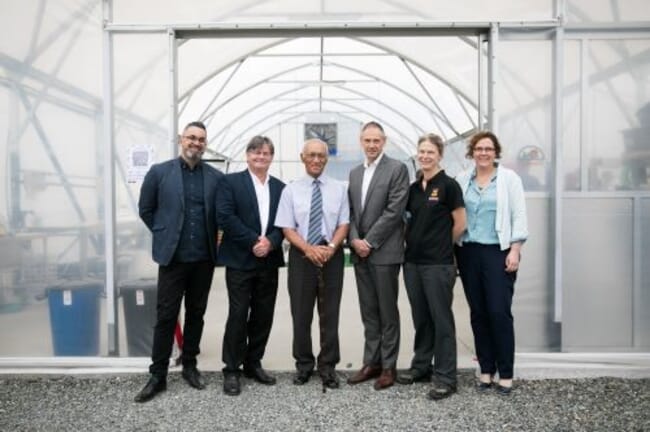
The Facility for Aquaculture Research of Macroalgae was officially opened by Joseph Macfarlane, Prof Chris Battershill, Tamati Tata, Prof Alister Jones, Dr Marie Magnusson and Prof Margaret Barbour.
Funded by the Tertiary Education Commission’s Entrepreneurial Universities programme and the University of Waikato, the 1,000m2
facility is the first in New Zealand to provide state-of-the art infrastructure for seaweed cultivation – from nursery stages to grow-out – and aims to deliver closed life-cycle aquaculture production of seaweed.
Leading the algal biotechnology research project is seaweed biologist Dr Marie Magnusson, alongside seaweed chemist and husband Dr Christopher Glasson, ecologist Rebecca Lawton and a world-class team of research fellows, technical officers and postgraduate students.
A lucrative industry for the Bay of Plenty
Dr Magnusson said Tauranga’s harbour is subject to recurring blooms of green seaweed (sea lettuce) and while the blooms are deemed a pest, this species of seaweed may hold the key to a lucrative industry in the Bay of Plenty.
“We’re exploring ways of using sea lettuce to develop food and agricultural products,” she said.
Dr Magnusson said macroalgae represent a largely untapped resource for materials and bioproducts that will enable sustainable diversification of New Zealand’s aquaculture industry.
“We’re researching commercial applications of seaweed and potential ways to use macroalgae and their extracts for agricultural, human and animal health, and materials science applications,” she added.
Seaweed is a huge multi-billion dollar industry in Asia, particularly red and brown seaweed, but the potential of green seaweed is yet to be fully explored and maximised.
“Sea lettuce has been our primary focus due to its abundance in our region, its amenability to cultivation and its fascinating bioactive properties. Previous research in Australia has shown a similar species had cardiovascular and weight management benefits in obese rats,” said Dr Magnusson, who previously headed the Centre for Macroalgal Resources and Biotechnology at James Cook University, Australia.
From sea pest to salad
“Sea lettuce has a range of applications from watering your garden with seaweed extract, to eating it, to promoting general health and wellbeing both in humans and a range of animal production systems,” explained Dr Magnusson.
While the gelling properties in the soluble fibre extracted from sea lettuce can be used for health and nutraceutical products, Dr Magnusson and her team are also extracting salt, soluble fibre and protein from the residual biomass for use in different applications.
Dr Christopher Glasson said the new facility in Tauranga will assist the team’s research into the bioactive properties of sea lettuce (ulva).
“Ulva can enhance the immune system to fight off infections and different diseases, but it can also enhance the immune system of plants against plant diseases, which can ultimately reduce the need for insecticides and pesticides in agriculture,” he said.
“A range of other products derived from sea lettuce, including biochar and nanocellulose composites, can be used to contribute to net carbon sequestration, reducing New Zealand’s carbon footprint.”
Freshwater production
As well as saltwater tanks housing the sea lettuce, the new aquaculture facility also has a number of freshwater tanks to address another main aspect of Dr Magnusson’s research programme.
“The freshwater algae in our facility have very good nutrient extraction and bioremediation properties which could assist in cleaning up our natural waterways,” she said. “Unfortunately our freshwater streams, rivers and lakes often have high levels of nitrogen. We can help to remove those excess nutrients by growing algae in the nutrient rich water of various discharge streams, as the algae takes up nitrogen and phosphorus to incorporate into its tissue for growth; when you harvest the biomass, you recover those nutrients from the system and at the same time produce a biomass resource for the development of value-added products.”
But the research does not stop at land-based aquaculture. “We’re developing and optimising controlled reproduction and seeding techniques for the large-scale production of seaweeds in open sea aquaculture systems, along with the optimisation of established production methods for land-based cultivation of green seaweeds and freshwater macroalgae for New Zealand species and environmental conditions,” said Dr Magnusson.
Dr Magnusson said the new facility is critical to the success of the team’s research as they look for solutions that will help reduce cattle methane emissions and fight agricultural and horticultural diseases in an environmentally sustainable way.
“We hope that in another two years we will have ocean farms growing seaweed as commercial crops as well as land based bioremediation facilities growing macroalgae to mop up excess nutrients and producing an algal crop for different applications, and hopefully some local ‘aquacultured’ seaweed products on the shelves,” she said.




